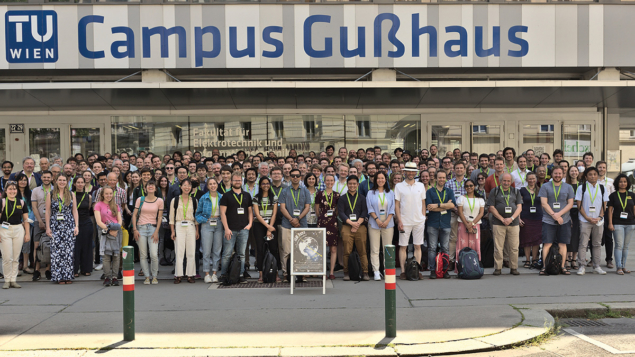
The international conference series on the identification of dark matter (IDM) was brought to life in 1996 with the motto that “it is of critical importance now not just to pursue further evidence for its existence but rather to identify what the dark matter is.” Despite earnest attempts to identify what dark matter comprises, the answer to this question remains elusive. Today, the evidence for dark matter is overwhelming; its amount is known to be around 27% of the universe’s energy-density budget. IDM2022 illuminated the dark-matter mystery from all angles, ranging from cosmological evidence via astrophysics to possible dark-matter particle candidates and their detection via indirect searches, direct searches and colliders.
The 14th edition of IDM took place in Vienna, Austria, from 18 to 22 July, attracting about 250 physicists and more than 200 contributions. The conference was initially scheduled for 2020 but changed to an online format due to the pandemic, while the in-person IDM was delayed until 2022. Many young scientists were able to meet the dark-matter community for the first time “in real life”. The Strings 2022 conference took place in Vienna simultaneously, with complementary presentations.
One focus of IDM2022 was the direct detection of dark matter. Tremendous progress in the sensitivity of direct detection experiments has been achieved in the past few decades over a wide dark-matter particle mass range. All major experiments presented their latest results. While in the past, direct searches focused on the classical WIMP region in a mass between a few GeV and several TeV, the search region is now enlarged towards even lighter dark-matter particles down to the keV region. Different mass regions require different technologies and new ideas were presented to increase the sensitivities towards these unexplored mass regions. For GeV WIMP dark-matter searches, the XENON collaboration displayed the first results from their latest setup, XENONnT, which has a significantly lower background level and recently eliminated a previously seen excess in XENON1T. The XENON, Darwin and LZ collaborations recently formed the XLZD collaboration with the aim of building a next-generation liquid-xenon experiment.
While the XENON1T excess is gone, direct-detection experiments exploring the sub-GeV mass regime still face unknown background contributions, especially in solid-state detectors. This is currently one of the biggest obstacles to increasing the sensitivity to even smaller cross-sections. No complete understanding has been achieved so far, but combining the results, knowledge and expertise of the experiments points to stress relaxations in crystals as one primary underlying source. To tackle this tricky problem, a subset of the IDM2022 participants held a dedicated satellite meeting. This EXCESS workshop was the third event of its kind, and the first to take place in person.
The direct detection experiment DAMA has observed a statistically significant signal of an annual modulated event rate for several years. This observation is consistent with Earth moving through the dark-matter halo, but has not been confirmed by any other experiment. DAMA recently reduced the energy threshold to 0.5 keV electron equivalent by upgrading their readout electronics to further increase sensitivity. Several new dark-matter experiments based on the same target material – NaI – are running or being commissioned to provide more information on the long-standing DAMA observation: ANAIS, COSINE, COSINUS and SABRE. Even lighter forms of dark matter, such as axions and axion-like particles, were discussed, as well as the possibility that dark matter comprises bound states.
Primordial black holes are also attractive potential dark-matter candidates. Astronomical data from, for example, microlensing, structure formation and gravitational waves hint at their existence. However, current data gives no handle on whether primordial black holes could be responsible for all the universe’s dark-matter content, or only correspond to part of the overall dark-matter density. Besides black-hole mergers, gravitational-wave signals can provide additional information to understand the origin of dark matter. In particular, processes in the early universe detected via gravitational waves could provide new insights into the particle nature of dark matter. With the increased sensitivity of operating and future gravitational-wave detectors, new players will provide additional data to unravel the dark-matter problem.
With a plethora of new ideas and experiments presented at this year’s IDM, the path is prepared for the next edition in L’Aquila, Italy, in 2024.







